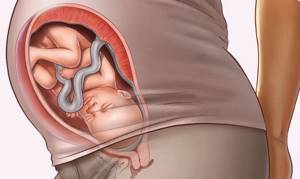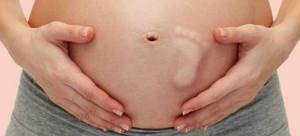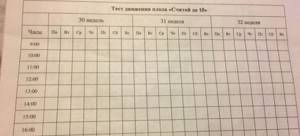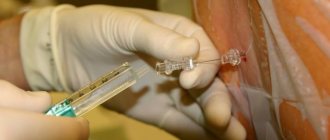One of those sensations that is remembered for a lifetime for women is the first movements of the fetus during the first pregnancy. According to the observations of physiologists, this happens closer to the middle of the 2nd trimester of pregnancy. However, some expectant mothers claim that the first “connection” with the baby occurred earlier.
At what stage of pregnancy does the fetus begin to move?
This question interests all expectant mothers. However, those who are carrying their first baby are more worried about this. The fact is that such women have no idea how the first movements of the fetus are felt during the first pregnancy and how not to confuse them with habitual digestive disorders. When determining the timing of the first movements, doctors advise being wary of your well-being closer to the beginning of the second trimester.
According to the statements of embryologists who carefully study the development of the baby in the mother’s womb, the first fetal movements during the first pregnancy are observed at 7-8 weeks
. However, the fetus is still so small and the range of movements is low that no mother can capture them. When the fetus begins to move with such amplitude and force that the woman herself feels it, she is already in the second trimester of pregnancy.
34th week of pregnancy: woman's feelings
Naturally, now you think more often about the upcoming birth. There is less and less time left before the appointed date, and you are sensitively listening to your feelings. This remaining month before giving birth is really something to get through. Many deep down experience the fear of childbirth. Some women worry that being overweight can lead to some complications during childbirth. Another, more fragile, is worried that she will not be able to give birth to a child on her own. But long before birth, the doctor calculates the ratio of the fetus and the size of the pelvis. And if there were any problems, he would probably tell you about it. In addition, it is important to understand that the size of the pelvis correlates with your height, and even with a narrow pelvis there is every chance of giving birth to a child on your own. Moreover, the modern approach to childbirth allows us to solve this problem without a caesarean section. Now the fundus of the uterus is located at a level of 34 cm from the symphysis pubis. Naturally, your organs cannot help but feel the increased pressure on them. There is a feeling that you are not getting enough air. This occurs due to tightness in the diaphragm. And you have to straighten and raise your shoulders to get the missing oxygen. Again, the vascular system also suffers. As a result, the manifestations of varicose veins become more noticeable. The digestive system also reminds itself from time to time. Heartburn, constipation and pain in the right hypochondrium often occur.

Continue to count your baby's movements every day. There should be four to six of them within an hour. As a rule, noticeable deviations from the norm - more frequent or much rarer movements - are a reason to be wary. Be sure to consult your doctor. This symptom indicates intrauterine discomfort in the child. Something is going wrong. Pay attention to your condition. If you notice an increase in swelling in your legs and arms, it is possible that dropsy of pregnancy is progressing. The fact is that the swelling you notice may be just the tip of the iceberg. Similar ones can occur inside, squeezing blood vessels and thereby impairing the supply of oxygen and nutrients to the placenta. In the later stages, this disease can even lead to the death of the child. Regular medical supervision in this case is extremely necessary for you and your baby.
When can you feel your baby move?
Women notice distinct first movements during their first pregnancy only at 20 weeks
. According to statistics, multiparous women record the first movements of the child 14 days earlier, at about 18 weeks. However, these indicators are individual, and the norm values fall within the boundaries between 18 and 24 weeks of pregnancy. At the same time, the very fact of the first movements of the fetus during the first pregnancy is not given the same importance as in later stages.
Thus, obstetricians can tell by the number of episodes of activity of the unborn baby per day whether everything is normal with him. In this regard, doctors always pay attention to the need for such monitoring. For many pregnant women, this becomes such a habit that they begin to count almost automatically. This can partly be explained by the fact that every time he visits a doctor, he is interested in the values of this indicator.

34th week of pregnancy: vaginal discharge
In late pregnancy, when the cervix opens slightly and the uterus is looser, the risk of infections increases. Therefore, watch your discharge very carefully. Flaky discharge may indicate the development of thrush. It is accompanied by itching. If you notice the appearance of pus in the discharge, it is possible that staphylococci or streptococci have entered the vagina. Similar symptoms occur when ingested by E. coli. Blood in the discharge may indicate placental abruption. Although in some cases bleeding is not noted, a hematoma simply appears inside. Moreover, in some cases, a woman feels abdominal pain in a specific place. If you do not see a doctor and the placental abruption occurs in a large area, the baby's oxygen supply may be cut off. Now you understand how important it is to prevent such developments in time. No less dangerous for the child’s life is the premature rupture of amniotic fluid. Sometimes this is preceded by contractions, then we are talking about premature birth. But sometimes genital tract infections can also provoke leakage of amniotic fluid. In both cases, it is necessary to seek medical help and undergo additional examination.
The first fetal movements during the first pregnancy - sensations
These sensations are such an individual parameter that it cannot be applied to all pregnant women. The first movements during the first pregnancy are described differently by everyone. The intensity and degree of sensations partly depend on which wall of the uterus the placenta is attached to, as well as on the body constitution of the pregnant woman.
How to feel the baby move?
In the third trimester of pregnancy, when the baby’s movements are clearly felt, expectant mothers do not have such questions. However, around the middle of the second trimester, many begin to pay more attention to their well-being. However, not everyone knows how to correctly listen to the first movements during pregnancy. To catch them, doctors recommend doing the following:
- lie down on a bed or sofa;
- place your palms in the lower abdomen, just above the pubic symphysis;
- lie quietly, without moving, and listen until light tapping begins to be felt under your palm.
What does fetal movement feel like during pregnancy?
Trying not to miss the moment, waiting for the baby to get in touch, expectant mothers ask their experienced friends what the fetal movements can be compared to. However, there is no consensus or answer. If you ask several women who have already become mothers how the first fetal movements feel during their first pregnancy, each will describe this moment in their own way.
Some compare the sensations to those that occur in the stomach during flatulence, others describe them as the splashing of a fish in an aquarium, or the fluttering of a butterfly. In practice, everything depends on the woman’s imagination and ability to describe her feelings. However, women pregnant with their second child can easily determine when the baby is moving.
When does the baby start to move?
When the embryo reaches 2 cm at 7–8 weeks, it makes its first movements. Since the nervous system is already ripe for conducting impulses in the tissue. But since it is floating freely in the uterine cavity, the pregnant woman does not feel its movements.
By week 12, shoots are formed that will soon become arms and legs. The belly-dweller moves them chaotically, but there is so much space that these movements are still imperceptible.
Closer to the 15th week, there is less and less space in the uterine cavity, because the belly is growing rapidly. His thrusting becomes more active. Time passes, it grows, resting against the walls of the uterus, and after 18 weeks the mother is ready for the first time to feel the first movement of the fetus. You can read about how the fetus develops in the mother’s tummy in the article: “Intrauterine development of the fetus.”
From the moment of the first push and progressively, the mother will feel all its movements more and more strongly. Only in the last weeks of gestation will the baby calm down slightly, since there will be no room left in the uterine cavity for somersaults.
What standards exist for fetal movements and activity?
The baby has its own life in its tummy, after the mother feels the first movements. He actively moves his arms, touches his face, plays with the umbilical cord and even hiccups. You can learn about how a pregnant woman feels when her belly hiccups from the article: “The baby hiccups in the stomach. Normal or pathological?
Scientists have calculated that by 20 weeks the baby in the belly makes about 200 movements per day. The belly dweller only calms down when he sleeps. The older the baby gets, the more he moves, and by the 30th week you can count up to 600 movements. After 32 weeks, activity decreases due to cramped conditions. Of course, the mother cannot feel all the movements, but according to medical standards she should feel the following:
- after 28 weeks – 8–10 movements per hour.
The exception is sleep, which usually lasts up to 4 hours at a time.

How to count fetal movements?
To assess the condition of the fetus without resorting to the use of hardware methods, doctors advise counting fetal movements. At the same time, gestational age does not in any way affect how often the baby should move. Over time, the indicator does not change, which makes it much easier to carry out such calculations. However, to obtain reliable data, it is necessary to follow the counting rules.
How many times should the fetus move?
In order not to worry about the condition of the baby and independently determine that everything is fine with him, every pregnant woman should know how many times a day the fetus moves. The frequency and nature of physical activity are the simplest indicators, the assessment of which does not require special knowledge and skills. In this case, monitoring of physical activity must be carried out throughout the day.
The optimal time for counting is from 9.00 to 19.00. If until 26-28 weeks fetal movements during the first pregnancy may not be felt every day, then from this period they become constant. During the day, the baby should “get in touch” at least 10 times. Moreover, each episode can include several movements of the unborn child.

Fetal movement test "Count to 10"
This test was developed by D. Pearson and is the most common. In some CIS countries, it is included in the list of activities recommended by the Ministry of Health for assessing the condition of the fetus. The fetal movement test can be used from 28 weeks of gestation and does not require special conditions. All entries are made in a special table. The pregnant woman enters the time of every 10th movement in the interval from 9 to 21.00. Upon completion of the calculations, the data obtained are assessed:
- the tenth episode of movements is recorded before 17.00 – the norm;
- the number of episodes of physical activity is less than 10 in 12 hours - you must seek medical advice;
- absence of movement within 12 hours – emergency hospitalization followed by ultrasound examination.
How to understand the baby's movements?
It has been established that the nature, amplitude and intensity of movements depend on how the child feels in the mother’s womb. Correct assessment of these parameters allows doctors to make a preliminary conclusion, according to which ultrasound may be required in some cases. In addition, the expectant mother herself, assessing how the baby is moving in her stomach, can suspect something is wrong in time and consult a doctor for help. Timely medical intervention can prevent the development of pregnancy complications, and in some cases, save it.
Frequent fetal movements
When, over a short period of time, the baby’s movements during pregnancy become intense and frequent, the expectant mother needs to be wary. In this way, in most cases, the child wants to tell his mother that he is experiencing anxiety and suffering. This situation may indicate the development of fetal hypoxia, when the baby does not receive enough oxygen, which negatively affects his brain and his condition as a whole.
Another situation is when during pregnancy the baby simply moves frequently and turns over. Excessive motor activity may indicate an infant's temperament. However, in such cases, the movements do not have a high amplitude, they are not sharp and do not cause pain to the woman. Sometimes increased activity indicates the fetus’s demand for the mother to change her body position.
Rare fetal movements
In certain situations, a decrease in a baby’s motor activity may be normal. The baby calms down when the mother feels cold, worries, worries, or is in one position for a long time. Changing these conditions often leads to the restoration of activity of the unborn child.
If this does not happen and the baby practically does not communicate for 12 hours, it is necessary to exclude a condition such as fading pregnancy. In this case, the child’s movements are not recorded, the development of the fetus stops and it dies. When performing an ultrasound, doctors do not record the heartbeat, and the established indicators of physical development do not correspond to the gestational age.
Weak fetal movements
Weak movements, but at the same time with the required frequency, are a variant of the norm. The movement of the fetus may not be clearly felt by the pregnant woman if the expectant mother is overweight. In this case, the kicks and pushes applied by the baby to the wall of the uterus are transmitted worse to the abdominal wall and are practically not detected by the pregnant woman herself. At the same time, according to the results of ultrasound, doctors do not record pathological changes.
It is the frequency rather than the strength of the shocks that is important. However, some doctors, based on what the woman said, can conclude that the fetus is insufficiently developed and the size of the baby does not correspond to the gestational age. But with the help of ultrasound examination it is possible to completely eliminate doubts regarding this.

Sudden fetal movements
In most cases, sudden movements of the fetus are caused by uncomfortable sensations. When the mother takes an uncomfortable position, the fetus instantly reacts to the changes taking place and lets her know about it with sharp, active kicks. When the body position changes, the woman notices how the child calms down and behaves quietly.
However, such a situation may also indicate possible violations. The main ones are hypoxia and increased uterine tone. In the first case, the baby feels oxygen starvation and tries with all his might to tell his mother about it. In the second case, tension in the walls of the uterus leads to a decrease in internal space: the fetus begins to respond to rhythmic contractions of the muscle layer. Both situations require additional monitoring by doctors.
34th week of pregnancy: preparing for childbirth
You visit a gynecologist weekly. And I have already purchased everything necessary for childbirth, including diapers, baby vests, rompers, and hats. If your mother also remembers that children in the maternity hospital were swaddled tightly before, now everything is different. Often, from the first or second day, children are immediately dressed in romper vests. Don’t be shy to clarify with your doctor anything you don’t understand. Now it won’t hurt you to be confident that you’ve thought through everything and taken everything into account. At least there is still some time to prepare. It’s better to think before the baby is born where his crib will be located and everything that you will need at first. It would be a good idea to at least roughly collect the things that you will need at the right time on the way to the maternity ward. In this case, you will feel calmer and will not condemn your family to hastily searching for the things you need. Ultrasound: If before this you were afraid of possible placenta previa, at the next ultrasound examination you can see that this diagnosis has been removed. Now, if bleeding occurs, the only reason for this can only be placental abruption. The baby in the womb is not always awake and asleep at the same time as its mother. Its rhythms may vary. The baby's body proportions have changed slightly and he is gaining weight. The baby's head is still larger than his body. And the bones of the skull are still soft.









